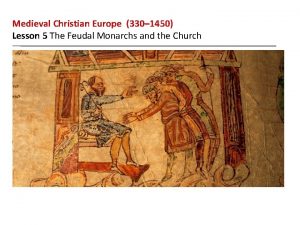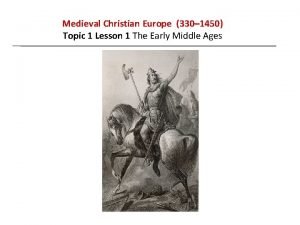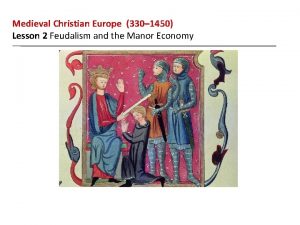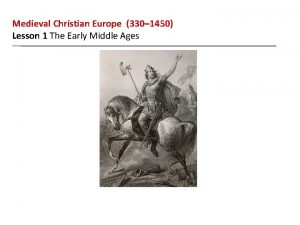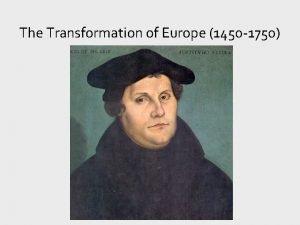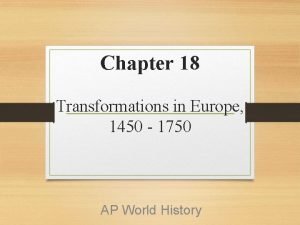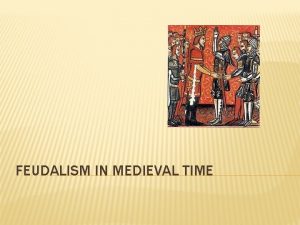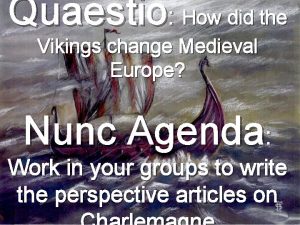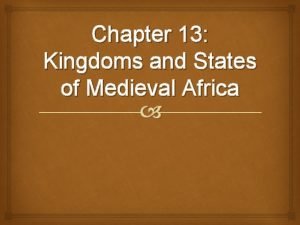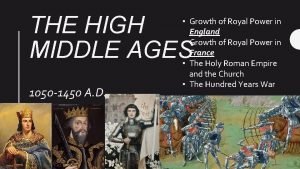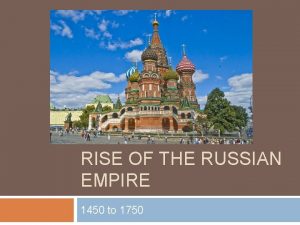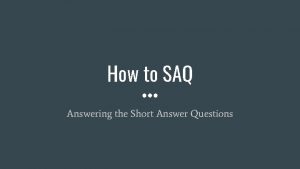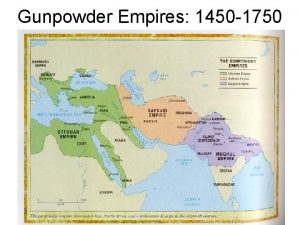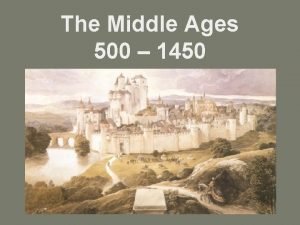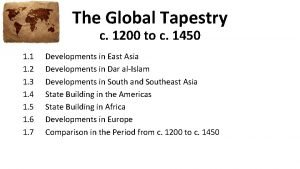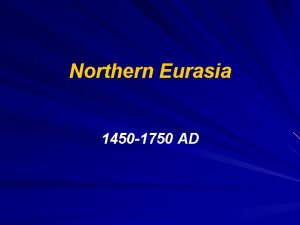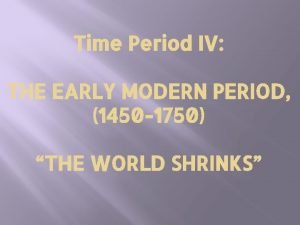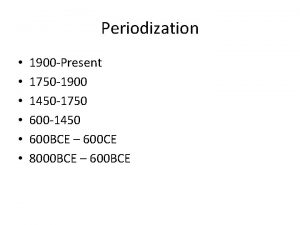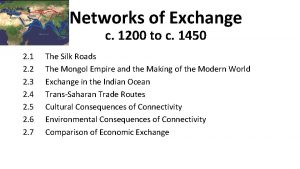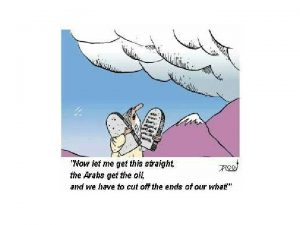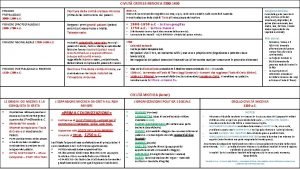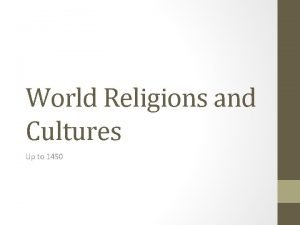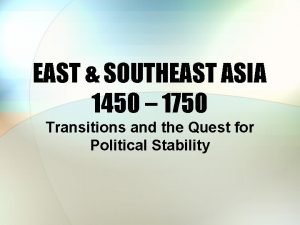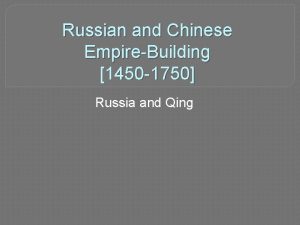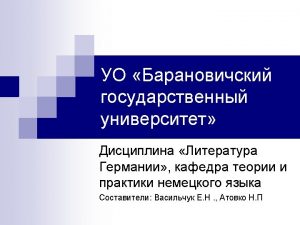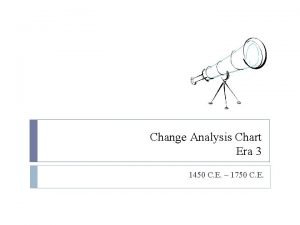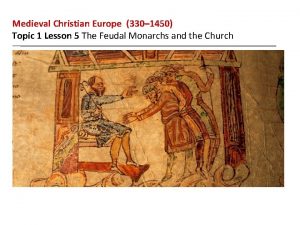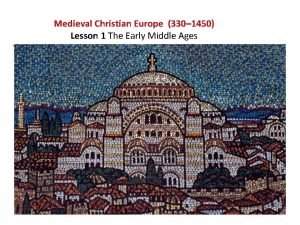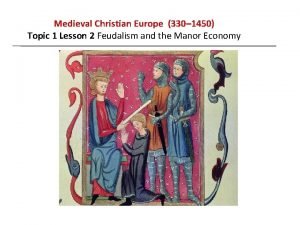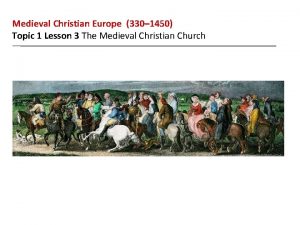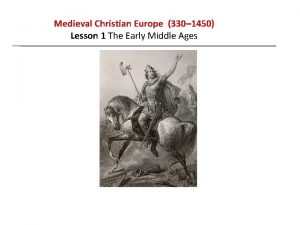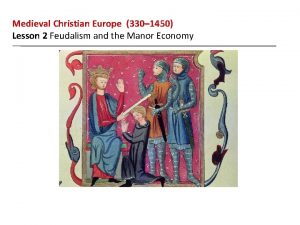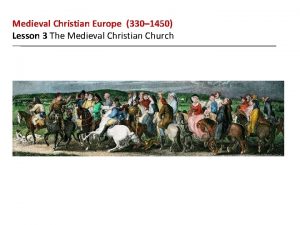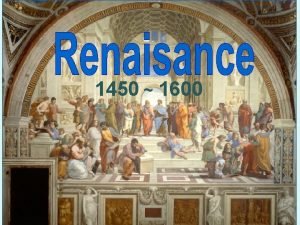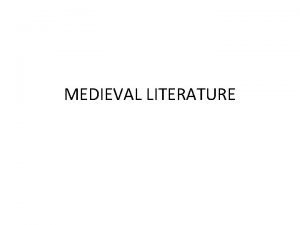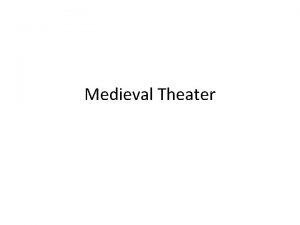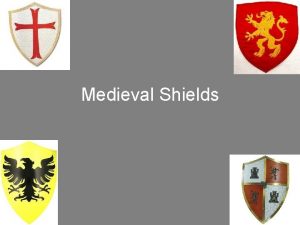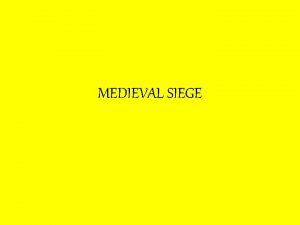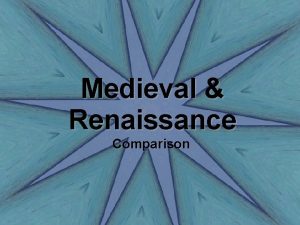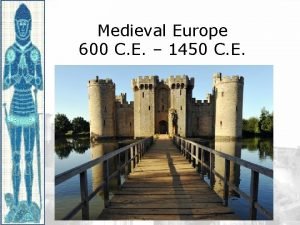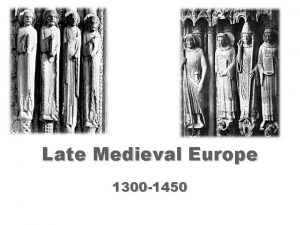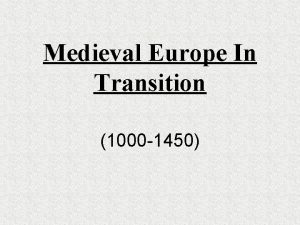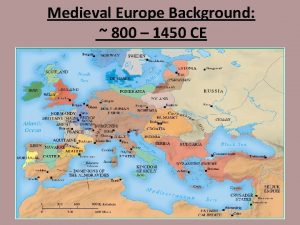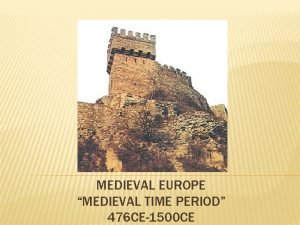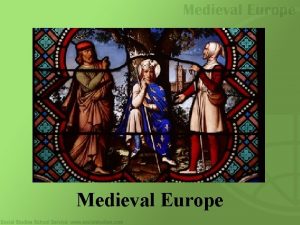Medieval Christian Europe 330 1450 Lesson 1 The
































- Slides: 32

Medieval Christian Europe (330– 1450) Lesson 1 The Early Middle Ages

Medieval Christian Europe (330– 1450) Lesson 1 The Early Middle Ages Learning Objectives • • Summarize ways in which the Byzantine empire flourished after the decline of Rome. Explain the impact of the fall of Rome on Western Europe. Describe how Germanic tribes carved Europe into small kingdoms. Explain how Charlemagne briefly reunited much of Western Europe and what happened to his empire after his death.

Medieval Christian Europe (330– 1450) Lesson 1 The Early Middle Ages Key Terms • • • • Constantinople. Justinian, Justinian’s Code. autocrat, Theodora. medieval Franks. Clovis, Charles Martel battle of Tours Charlemagne Magyars, Vikings.

The Byzantine Empire Thrives In European history, the thousand-year span between the fall of the Roman empire and the Renaissance beginnings of modern history is known as the Middle Ages. Perhaps best remembered today for knights on horseback and towering Gothic cathedrals, this medieval period began with the collapse of the western Roman empire.

The Byzantine Empire Thrives • • Constantinople Grows A Blending of Cultures

The Byzantine Empire Thrives Major European and Asian trade routes met at Constantinople. Analyze Maps Summarize Constantinople's protective advantages.

The Byzantine Empire Thrives Constantinople, the wealthy Byzantine capital, rises behind strong walls to the great domes of the church of Hagia Sophia and beyond in this mosaic from London's Westminster Cathedral.

The Age of Justinian The Byzantine empire reached its greatest size under the emperor Justinian, who ruled from 527 to 565. Justinian was determined to revive ancient Rome by retaking lands that had been overrun by invaders.

The Age of Justinian • • • Hagia Sophia Justinian’s Code and Its Impact Justinian Rules With Absolute Power Economic and Military Power The Empire Declines

The Age of Justinian Hagia Sophia first served as a cathedral for more than 900 years, then as a mosque for nearly 500 years. A Turkish museum since 1935, it remains a magnificent presence.

The Age of Justinian commissioned an important reform of ancient Rome's laws. Analyze Charts How did Justinian's Code help rule the Byzantine empire? Why did the Code become so valuable later?

The Age of Justinian The Byzantine empire reached its greatest size by 565. Analyze Maps Describe the Byzantine empire's extent in 1020. Infer What does the empire's size in 565 suggest about Justinian’s rule?

Changes in Western Europe In Europe, the centuries after the fall of Rome are called the Middle Ages, which lasted from about 500 to 1350. The Middle Ages refers to the time between the ancient and modern worlds. During this long stretch of time, Western Europe passed through two distinct phases: the early Middle Ages, lasting from about 500 to 1050, and the late Middle Ages, lasting from about 1050 to 1350.

Changes in Western Europe • • A Shift to the North A Time of Decline

Changes in Western Europe Analyze Graphs When does Rome's greatest population drop in thousands occur? the greatest percentage drop? Draw Conclusions What does the information in this graph tell you?

Germanic Kingdoms The Germanic tribes that conquered parts of the Roman empire included the Goths, Vandals, Saxons, and Franks. Their culture was very different from that of the Romans. They were mostly farmers and herders, so they had no cities or written laws. Instead, they lived in small communities governed by unwritten customs. Their kings were elected leaders, chosen by tribal counsels. Warriors swore loyalty to the king in exchange for weapons and a share in the plunder taken from defeated enemies. Between 400 and 700, these Germanic tribes carved Western Europe into small kingdoms.

Germanic Kingdoms • • The Kingdom of the Franks Muslim Armies Advance Into Europe

Germanic Kingdoms King Clovis of the Franks rallies his warriors during one of many battles he fought to build his kingdom. His conversion to Christianity set an example for other Germanic rulers.

Charlemagne Builds an Empire In 768, the grandson of Charles Martel became king of the Franks. He built an empire reaching across what is now France, Germany, and part of Italy. The founder of this empire became known as Charlemagne (SHAHR luh mayn), or Charles the Great.

Charlemagne Builds an Empire • • Emperor of the Romans Creating a Unified Christian Empire Charlemagne Revives Latin Learning Charlemagne's Legacy

Charlemagne Builds an Empire In this medieval illustration, Pope Leo III crowns a kneeling Charlemagne Emperor of the Romans in 800 before an assembly of concerned churchmen. Explain. Why did this event cause controversy?

Charlemagne Builds an Empire Charlemagne built an empire his descendants could not hold together. Locate Charlemagne's empire in 814. Predict Consequences What might be one result of the division of his empire? Explain.

New Invasions Pound Europe After Charlemagne died in 814, his son Louis I took the throne. Later, Louis’s sons battled for power. Finally, in 843, Charlemagne’s grandsons drew up the Treaty of Verdun, which split the empire into three regions. The empire was divided just at a time when these lands were faced with new waves of invasions.

New Invasions Pound Europe • • Three Sources of Attack Viking Raids from the North

New Invasions Pound Europe Analyze Maps Use the map to find total distances the invaders traveled and number of routes taken. Rank the invaders from longest to shortest total distances traveled and most to least routes taken.

New Invasions Pound Europe This is a modern replica of a Viking ship built around 820 and found buried in western Norway in 1903. Thirty oarsmen, a lookout, and man at the tiller would have sailed that ship.

Quiz: The Byzantine Empire Thrives What elements of Constantinople's location helped it flourish as the capital of the Byzantine empire? A. B. C. D. its location on a great river and surrounded by high mountains its location on a strait between seas and on key trade routes its location far from trade routes and close to threatening tribes its location beside a huge lake and bordered by two vast deserts

Quiz: The Age of Justinian How did Justinian's Code have an impact beyond the Byzantine empire? A. B. C. D. It provided models for strong alliances between monarchs. It organized ancient Roman laws for use within the empire. It promoted trade among Europe, the Middle East, and Asia. It later guided the development of present-day international law.

Quiz: Changes in Western Europe How did the collapse of the western Roman empire affect Western Europe? A. B. C. D. Western Europe's traders grew wealthy. Western Europe supported classical learning. Western Europe fell into disorder as invaders swept in. Western Europe's people moved to cities.

Quiz: Germanic Kingdoms How did the culture of the Germanic tribes differ from that of the Romans? A. B. C. D. Germanic peoples were mostly traders, so they traveled throughout Europe. Germanic peoples lived in small communities governed by unwritten customs. Germanic kings were chosen by single combat between warriors. Germanic peoples lived in great cities administered by a central government.

Quiz: Charlemagne Builds an Empire Which was a major effect of Pope Leo III crowning Charlemagne Emperor of the Romans? A. B. C. D. decline of Latin learning throughout Europe future collaboration between popes and emperors unification of the eastern and western Roman empire revival of the ideal of a unified Christian community

Quiz: New Invasions Pound Europe Which BEST summarizes the impact of the Vikings on Western Europe? A. They burned and looted in Western Europe and disrupted Mediterranean trade routes. B. They mixed with local populations in Western Europe, helping to unify Charlemagne's empire. C. They burned and looted, but also established trade routes and settled in Western Europe. D. They set up a colony in North America, but also disrupted trade routes to northern Europe.
 Which actions did french kings take to increase royal power
Which actions did french kings take to increase royal power Topic 1 medieval christian europe
Topic 1 medieval christian europe Feudal europe map
Feudal europe map Medieval kingdoms in europe lesson 1
Medieval kingdoms in europe lesson 1 Europe 1450
Europe 1450 Europe map 1750
Europe map 1750 Medieval europe feudal system
Medieval europe feudal system “how did the vikings change medieval europe?”
“how did the vikings change medieval europe?” Lesson quiz 13-1 kingdoms and states of medieval africa
Lesson quiz 13-1 kingdoms and states of medieval africa Mughal empire 1450 to 1750
Mughal empire 1450 to 1750 1450 ad
1450 ad Best buy in st george utah
Best buy in st george utah Fur trade ap world history
Fur trade ap world history Russian empire art and architecture 1450 to 1750
Russian empire art and architecture 1450 to 1750 Saq examples
Saq examples Land based empires 1450 to 1750
Land based empires 1450 to 1750 Apwh period 3
Apwh period 3 500/1450
500/1450 Global tapestry definition
Global tapestry definition Japan 1450-1750
Japan 1450-1750 World map 1450
World map 1450 1750-600
1750-600 C-1450-2
C-1450-2 1250 bc
1250 bc 2300-1450
2300-1450 Toreador fresco meaning
Toreador fresco meaning Religion in 1450 to 1750
Religion in 1450 to 1750 Southeast asia 1450 to 1750
Southeast asia 1450 to 1750 Russian empire 1450-1750
Russian empire 1450-1750 Renaissance history event
Renaissance history event Realismus geschichtlicher hintergrund
Realismus geschichtlicher hintergrund Change analysis chart 1450 to 1750
Change analysis chart 1450 to 1750 S-330 nwcg
S-330 nwcg
